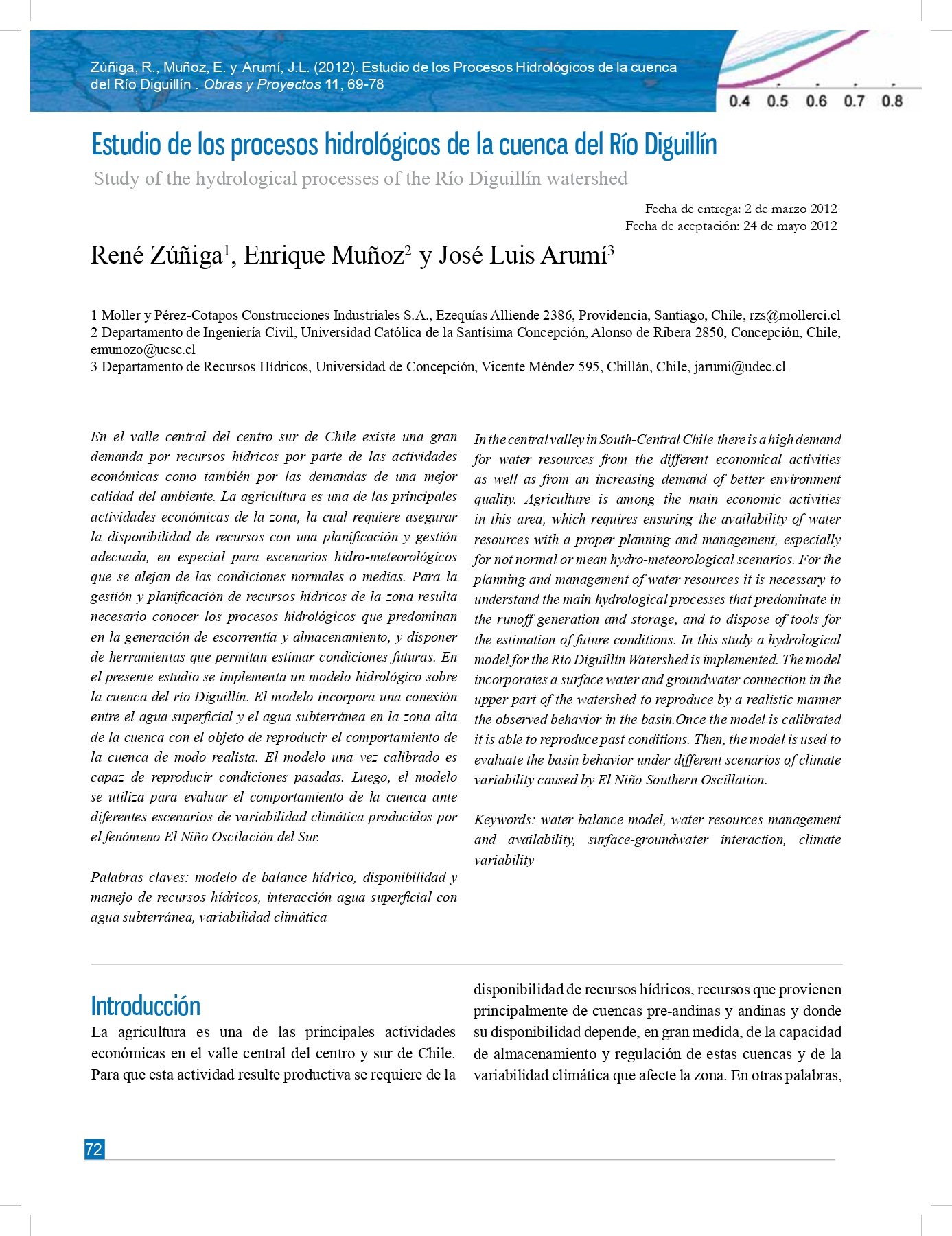Study of the hydrological processes of the Río Diguillín watershed
DOI:
https://doi.org/10.4067/S0718-28132012000100007Keywords:
water balance model, water resources management and availability, urface-groundwater interaction, climate variabilityAbstract
In the central valley in South-Central Chile there is a high demand for water resources from the different economical activities as well as from an increasing demand of better environment quality. Agriculture is among the main economic activities in this area, which requires ensuring the availability of water resources with a proper planning and management, especially for not normal or mean hydro-meteorological scenarios. For the planning and management of water resources it is necessary to understand the main hydrological processes that predominate in the runoff generation and storage, and to dispose of tools for the estimation of future conditions. In this study a hydrological model for the Río Diguillín Watershed is implemented. The model incorporates a surface water and groundwater connection in the upper part of the watershed to reproduce by a realistic manner the observed behavior in the basin.Once the model is calibrated it is able to reproduce past conditions. Then, the model is used to evaluate the basin behavior under different scenarios of climate variability caused by El Niño Southern Oscillation.
References
Beven, K. and Binley, A. (1992). The future of distributed models: model calibration and uncertainty prediction. Hydrological Processes 6, 279-298. https://doi.org/10.1002/hyp.3360060305
Bottcher, W. (2011). Simulation of the precipitation-runoff behavior in the Diguillín Watershed (Central Chile). Diploma Thesis. Department of Physical Geography and Landscape Ecology, University of Leibniz Hannover, Germany.
Dixon, H. J., Murphy, M.D., Sparks, S.J., Chávez, R., Naranjo, J.A., Dunkley, P.N., Young, S. R., Gilbert, J. S. and Pringle, M.R. (1999). The geology of Nevados de Chillán volcano, Chile. Revista Geológica de Chile 26(2), 227-253. https://doi.org/10.4067/S0716-02081999000200006
Garreaud, R. D. (2009). The Andes climate and weather. Advances in Geosciences 22, 3-11. https://doi.org/10.5194/adgeo-22-3-2009
Grimm, A.M., Barros, V.R., and Doyle, M.E. (2000). Climate variability in southern South America associated with El Niño and La Niña events, Journal of Climate 13, 35-58. https://doi.org/10.1175/1520-0442(2000)013%3C0035:CVISSA%3E2.0.CO;2
Gupta, H. V., Kling, H., Yilmaz, K. K. and Martinez, G. F. (2009). Decomposition of the mean squared error and NSE performance criteria: implications for improving hydrological modeling. Journal of Hydrology 377, 80-91. https://doi.org/10.1016/j.jhydrol.2009.08.003
Montecinos, A. y Aceituno, P. (2003). Seasonality of the ENSO-related rainfall variability in central Chile and associated circulation anomalies. Journal of Climate 16(2), 281-296. https://doi.org/10.1175/1520-0442(2003)016%3C0281:SOTERR%3E2.0.CO;2
Muñoz, E., Álvarez, C., Billib, M., Arumí, J.L. and Rivera, D. (2011). Comparison of gridded and measured rainfall data for basin-scale hydrological studies, Chilean Journal of Agricultural Research 71, N° 3, 459-468. https://doi.org/10.15488/571
Muñoz, E. (2010). Desarrollo de un modelo hidrológico como herramienta de apoyo para la gestión del agua. Aplicación a la cuenca del río Laja, Chile. Tesis de Master, Departamento de Ciencias y Técnicas del Agua y del Medio Ambiente, Universidad de Cantabria, España.
Muñoz, E. (2011). Perfeccionamiento de un modelo hidrológico aplicación de análisis de identificabilidad dinámico y uso de datos grillados. Tesis de Doctorado, Departamento de Recursos Hídricos, Universidad de Concepción, Chillán, Chile.
Nash, J. and Sutcliffe, J. (1970). River flow forecasting through conceptual models part I: a discussion of principles. Journal of Hydrology 10(3), 282-290. https://doi.org/10.1016/0022-1694(70)90255-6
Ortiz, G., Muñoz, E. y Tume, P. (2011). Incerteza en las variables de entrada de un modelo hidrológico conceptual. Efectos sobre la incerteza en las salidas. XX Congreso Chileno de Hidráulica, Octubre 2011, Santiago, Chile.
Rango, A. and Martinec, J. (1995). Revisiting the degree-day method for snowmelt computations. Journal of the American Water Resources Association 31(4), 657-669. https://doi.org/10.1111/j.1752-1688.1995.tb03392.x
Vicuña, S., Garreaud, R. D., and McPhee, J. (2011). Climate change impacts on the hydrology of a snowmelt driven basin in semiarid Chile. Climatic Change 105: 469-488. https://doi.org/10.1007/s10584-010-9888-4
Wagener, T. and Kollat, J. (2007). Numerical and visual evaluation of hydrological and environmental models using the Monte Carlo analysis toolbox. Environmental Modelling and Software 22, 1021-1033. https://doi.org/10.1016/j.envsoft.2006.06.017
Willmot, C. and Matsuura, K. (2008). Terrestrial air temperature and precipitation: Monthly and annual time series (1900-2008) Version 1.02. University of Delaware, http://www.climate.geog.udel. edu/climate

Downloads
Published
Issue
Section
License
Copyright (c) 2012 Universidad Católica de la Santísima Concepción

This work is licensed under a Creative Commons Attribution-NonCommercial 4.0 International License.







